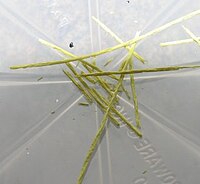
Photo from wikipedia
The ability to manipulate heterostructures is of great importance to achieve high-performance electrocatalysts for direct water-splitting devices with excellent activity toward hydrogen production. Herein, a novel top-down strategy involving the… Click to show full abstract
The ability to manipulate heterostructures is of great importance to achieve high-performance electrocatalysts for direct water-splitting devices with excellent activity toward hydrogen production. Herein, a novel top-down strategy involving the in situ transformation of one-dimensional MoO3 nanorod arrays grafted with two-dimensional NiS nanosheets supported on a three-dimensional nickel foam skeleton is proposed. Namely, a heterostructured electrocatalyst on the Ni foam skeleton containing MoO3 nanorod arrays decorated with NiS nanosheets is synthesized by a facile hydrothermal method followed by one-step sulfidation treatment. Experimental analysis confirmed that this novel composite has the merits of a large quantity of accessible active sites, unique distribution of three different spatial dimensions, accelerated mass/electron transfer, and the synergistic effect of its components, resulting in impressive electrocatalytic properties toward the hydrogen evolution reaction and oxygen evolution reaction. Furthermore, an advanced water-splitting electrolyzer was assembled with NiS/MoO3/NF as both the anodic and cathodic working electrode. This device requires a low cell voltage of 1.56 V to afford a water-splitting current density of 10 mA·cm-2 in basic electrolyte, outperforming previously reported electrocatalysts and even state-of-the-art electrocatalysts. More significantly, this work provides a way to revolutionize the design of heterostructured electrocatalysts for the large-scale commercial production of hydrogen using direct water-splitting devices.
Journal Title: Nanoscale
Year Published: 2020
Link to full text (if available)
Share on Social Media: Sign Up to like & get
recommendations!